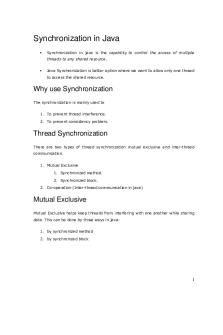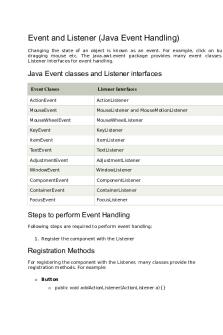Synchronization in Java PDF

| Title | Synchronization in Java |
|---|---|
| Author | Sakshi Bhalothia |
| Course | Java Programming |
| Institution | Banasthali Vidyapith |
| Pages | 11 |
| File Size | 93.6 KB |
| File Type | |
| Total Downloads | 148 |
| Total Views | 270 |
Summary
Synchronizati on i n Java Synchronization in java is the capability to control the access of multiple threads to any shared resource. Java Synchronization is better option where we want to allow only one thread to access the shared resource.Why use SynchronizationThe synchronization is mainly used...
Description
Sy nc hr oni z at i oni nJ av a
Synchronization in java is the capability to control the access of multiple threads to any shared resource.
Java Synchronization is better option where we want to allow only one thread to access the shared resource.
Whyus eSy nc hr oni z at i on The synchronization is mainly used to 1. To prevent thread interference. 2. To prevent consistency problem.
Thr eadSy nc hr oni z at i on There are two types of thread synchronization mutual exclusive and inter-thread communication. 1. Mutual Exclusive 1. Synchronized method. 2. Synchronized block. 2. Co-operation (Inter-thread communication in java)
Mut ual Ex c l us i v e Mutual Exclusive helps keep threads from interfering with one another while sharing data. This can be done by three ways in java: 1. by synchronized method 2. by synchronized block
1
Conc eptofLocki nJav a Synchronization is built around an internal entity known as the lock or monitor. Every object has an lock associated with it. By convention, a thread that needs consistent access to an object's fields has to acquire the object's lock before accessing them, and then release the lock when it's done with them. Class Table{
void printTable(int n){//method not synchronized for(int i=1;i...
Similar Free PDFs

Synchronization in Java
- 11 Pages

Loopsin Java - Loops in Java
- 9 Pages

Multithreading in Java
- 12 Pages

Access Specifiers in Java
- 4 Pages

Event Handling IN JAVA
- 6 Pages

Programmazione in Java Script
- 177 Pages

Chapter 05 - Process Synchronization
- 58 Pages

Klassen und Objekte in Java
- 5 Pages

Text Based Game in java
- 3 Pages

Design Patterns in Java Tutorial
- 168 Pages

Thinking in Java 4th edition
- 6 Pages

MCQs-java - Java Questions
- 15 Pages
Popular Institutions
- Tinajero National High School - Annex
- Politeknik Caltex Riau
- Yokohama City University
- SGT University
- University of Al-Qadisiyah
- Divine Word College of Vigan
- Techniek College Rotterdam
- Universidade de Santiago
- Universiti Teknologi MARA Cawangan Johor Kampus Pasir Gudang
- Poltekkes Kemenkes Yogyakarta
- Baguio City National High School
- Colegio san marcos
- preparatoria uno
- Centro de Bachillerato Tecnológico Industrial y de Servicios No. 107
- Dalian Maritime University
- Quang Trung Secondary School
- Colegio Tecnológico en Informática
- Corporación Regional de Educación Superior
- Grupo CEDVA
- Dar Al Uloom University
- Centro de Estudios Preuniversitarios de la Universidad Nacional de Ingeniería
- 上智大学
- Aakash International School, Nuna Majara
- San Felipe Neri Catholic School
- Kang Chiao International School - New Taipei City
- Misamis Occidental National High School
- Institución Educativa Escuela Normal Juan Ladrilleros
- Kolehiyo ng Pantukan
- Batanes State College
- Instituto Continental
- Sekolah Menengah Kejuruan Kesehatan Kaltara (Tarakan)
- Colegio de La Inmaculada Concepcion - Cebu



